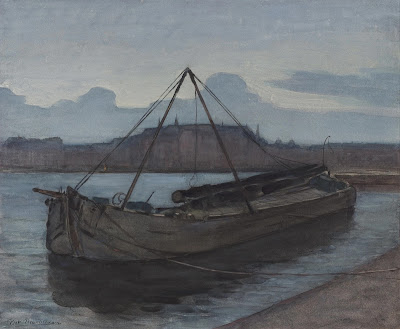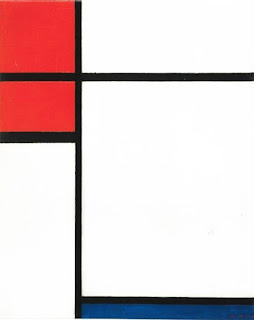40. De Stijl (Neoplasticism) (1917-1944) – The Dutch Copy Malevich
What was it about? What were the goals?
This was yet another art movement that advocated simple geometric shapes and primary colors in order to express the spiritual core of a subject - through a balanced, abstract composition. This particular movement branched heavily into architecture, which the artists sought to synthesize (join together) with painting.
At the heart of this movement was a theory, championed by Mondrian and Van Doesburg, which they titled Nieuwe Beelding (Neoplasticism). In it, they argued that all great artists make a compromise between the truth - how things really look - and harmony, what looks good. We've seen this debate before, during the Baroque (the Caracci family versus the Caravaggisti). Mondrian argued that a painter like Poussin could make a beautiful, harmonious painting, even if the figures were posed in stiff, unnatural ways. For Mondrian, the simple way to avoid this paradox was to paint completely abstract - taking away the need for realism, and getting a "pure plastic" art that feels comfortable, harmonious and balanced, without the need for pesky figures, etc. This was what he saw the history of art leading to - it's apex form - him. So, basically it was a way to separate himself from the crowd of other modern painters, and inflate his ego. There's more to it, and it's deliberately confusing. Here's how Mondrian and his followers phrased it:
The results of these theories was the creation of a new kind of art that explored composition in pure abstract forms, leading to innovative new creations, and especially buildings.
A bit of historical context:
There are two Dutch art movements (or periods) that make chapters in art history textbooks. The first is the Dutch Golden Age, which takes place during the Baroque period. Then there's this, De Stijl, which began in roughly 1917 and continued after WWII when most of the artists fled the Netherlands, moving to the US (mostly New York) for safety. Chief among these artists was Piet Mondrian, who began his career as an academic, painting realistic portraits and landscapes, then tried his hand at impressionism, fauvism, expressionism, and then cubism - desperate to figure some way to develop his own art form, so he could be a leader instead of merely another follower. As he began experimenting, other Dutch artists and intellectuals gravitated to him, working together to create De Stijl.
A major influence was Kandinsky's autobiography, which Mondrian and Van Doesburg read in 1911-13. Kandinsky wrote that painting takes on a spiritual element as it originates from the mind, rather than simply the world around us. This mind-over-matter approach pushed the De Stijl members in the direction of abstraction.
It’s not certain where De Stijl got its name, but it’s assumed to come from the writing of a Dutch architect, Gottfried Semper. The word stijl means style, but has a second meaning in Dutch – of a post or supporting beam, which explains so many of the bold, black vertical lines that seem to hold up these art works. Theo Van Doesburg began publishing an art journal in 1917 titled De Stijl to bolster the group's ideas and influence.
How was this different from Suprematism?
Yes. Many of these ideas cross over into Suprematism, which came first. It's interesting to see that Malevich wasn't named as an influence for De Stijl, perhaps because travel outside of Russia was limited during the Soviet Union? The only aesthetic difference I can see was that Malevich experimented more freely with dynamic diagonal lines, shapes, and orientations that are lighter and more explosive, whereas the De Stijl artists championed right angle relationships, everything firmly rooted and stuck together - solid and strong, like a building.
The underlying philosophy of the period:
Neoplasticism was the group's main philosophical approach to art making - which they tied to Theosophy (which means different things depending where you look). Some also discussed ideas of Elementalism - adding in the 4th dimension of time into their art. When Elementalism was introduced in 1924 artists began adding some 45 diagonal lines to the work.
Thoughts concerning architecture were heavily influenced by Gottfried Semper and Hendrik Berlage, who explained that architecture, unlike painting, was unburdened with notions of symbolic meaning, but mainly about beauty created by balanced ratios, rhythms, and tension from horizontal versus vertical planes. Mondrian and his peers looked for ways to combine painting and architecture:
How was it represented in other arts – music, architecture, and literature?
Apart from painting, sculpture, and architecture, a few artists, like Hans Richter and Viking Eggeling made short abstract films. Van Doesburg and Antony Kok strived to use De Stijl principles in poetry, creating "letter-sound-images". Mondrian also theorized about applying his principles to music theory, convincing the young composer Jakob Van Domselaer to write De Stijl music. Mondrian was obviously hoping his new style would catch on and create a legacy.
Was it great?
Sure? I see its greatest strength as a compositional exercise - to create harmony from simple lines and boxes, in a way that is decentral, asymmetrical, and non-representational. It's not as easy as it looks - try it! And, I've seen other artists do this to create amazing figurative compositions, like William O'Connor for example:
Are these works more than exercises? Or more than merely decorative? They are to some people, it's always open to your interpretation. But, even if all you see is bathroom tiles and necktie designs, decorative art is still valid, anything that makes a more pleasing place to live in.
Some leading figures:
Piet Mondrian (Dutch, 1872-1944)
Bart van der Leck (Dutch, 1876-1958)
Antony Kok (Dutch, 1882-1969) (poet)
Theo Van Doesburg (Dutch, 1883-1931)
Vilmos Huszár (Hungarian, 1884–1960)
Georges Vantongerloo (Belgian, 1886-1965) (sculptor)
Robert van 't Hoff (Dutch, 1887-1979) (architect)
Gerrit Thomas Rietveld (Dutch, 1888-1964) (architect)
Jakob Van Domselaer (Dutch, 1890-1960) (composer)
J. J. P. Oud (Dutch, 1890-1963) (architect)
Jan Wils (Dutch, 1891-1972) (architect)
Some of the most famous artworks of the time:


































.jpg)


























Comments
Post a Comment